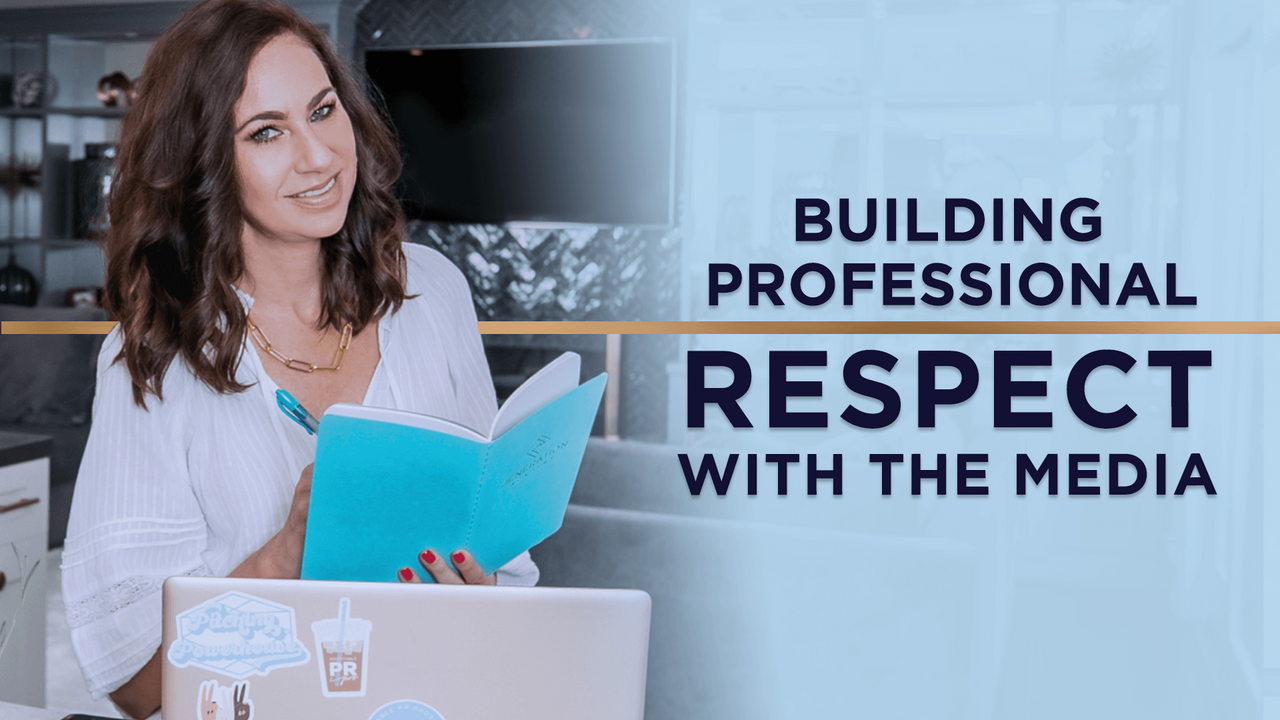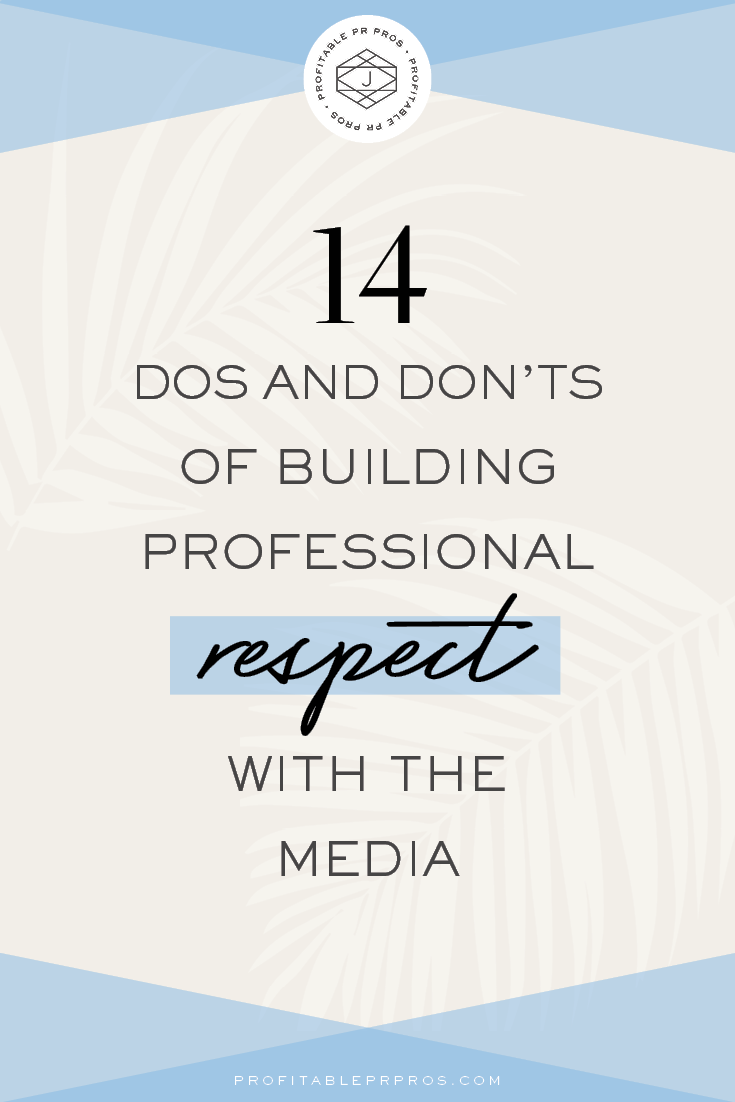14 Dos and Don'ts of Building Professional Respect with the Media
Mar 21, 2022
Try as we PR pros might, publicists don’t always have the best reputation with the media. There are a lot of shady “publicists” (yes, I’m using quotes!) who give PR pros a bad name, which can make it tough to create relationships with editors. And you know these media relationships are the key to finding success and landing great press for your clients! It’s up to you to be proactive and build professional respect with journalists by establishing yourself as trustworthy and helpful.
The Do’s and Don’ts of Building Professional Respect with the Media
But that’s all much easier said than done! It takes time, patience, and a lot of effort to build strong relationships with journalists and editors. Here are 14 dos and don’ts to develop media relationships built on professional respect.
DO Approach Pitching From the Perspective of Being a Helper
It’s all about service, service, service! Like with your clients, you should always work to be a helper to journalists and editors and constantly offer them value.
Think about how you can make a journalist’s job easier. If you see that a journalist is working on a new story, reach out with a source you know will be a good fit, even if it’s not one of your clients.
By making their lives even a little easier in this way, you’ll start to establish yourself as a valuable source. Journalists will begin to respect your opinion and expertise and trust that you’re genuinely there to help! If you’re giving them good information, they’ll want to keep working with you and keep that connection going.
Related: 6 PR Strategies To Keep Your Pitches Fresh (Even When There’s No News)
DON’T Pitch Clients Just to Pitch Them
The #1 way to lose professional respect with journalists is by sending them unnecessary pitches that don’t fit their story. Every time you send something irrelevant, it increases the chances of journalists ignoring your emails altogether!
Only pitch a journalist or editor when your client is truly a perfect match for a particular story or outlet. You wouldn’t pitch gardening tools to a fashion editor, right?
Be careful and thoughtful with your pitches, and always pitch to the editor working on the right beat for your client. Editors and journalists will thank you (and know that you’re up-to-date on their content!).
DO Handle All Requests Immediately
You NEVER want to make journalists late for a deadline. You need to deliver assets on time, every time. It’s not the editor’s job to track down the deliverables!
When you start working with a new client, get all the assets you need right off the bat to set yourself up for success. That way, you can start pitching as soon as possible, and there won’t be a delay when you respond to editors!
Journalists will know they can count on you to work with them in a frictionless, timely manner. They’ll see that they’ll never have to wait on you for anything, which seriously helps you earn professional respect.
DON’T Make Them Wait
Making sure journalists don’t wait on assets is half the battle. You also need to be on top of all communication with them. Never leave them waiting on responses or interviews!
Be realistic with your deliverable dates and how quickly you can get your client to show up for an interview. Keep track of your follow-up messages, and set reminders for yourself to reply to their latest message. You can even block out a chunk of time each day to go through your inbox and respond to editors!
DO Invite Journalists to Coffee Dates
Whether you’re meeting at your local cafe or over zoom, a coffee date is a perfect way to build rapport with a journalist and build professional respect outside of your inboxes. Just 15-30 minutes is enough to seriously strengthen your relationship with a journalist and build professional respect with them!
If you’re meeting virtually, send over a gift card to a coffee shop nearby. You could even send over a few cans of coffee (La Colombe is a favorite!) or a cute new mug.
While you’re chatting, be sure to ask what they’re working on right now and how you can support them. It’s a more personal way to establish yourself as helpful and knowledgeable in your niche.
DON’T Create One-Sided Relationships
Go deeper! A relationship should be give-and-take: you shouldn’t just be in this to get the press placements and features you want for your clients.
Think about how your relationship can be valuable and of service to the journalist, too. You’ll more easily form a mutually beneficial relationship based on genuinely helping each other.
It starts with you helping them by offering sources. From there, your relationship will grow into them helping you by including your clients in their stories!
DO Tailor Your Pitches
Without exception, tailor your pitches to the editor and the story they’re working on or the beat they cover. You’ll establish yourself as a trustworthy source of information, which seriously helps you earn professional respect.
Show that you have a timely, relevant, strategic, targeted pitch for the exact editor you’re pitching. Never use a spray-and-pray tactic!
Tailoring your pitches is what we cover inside The Pitch Lab! You’ll learn to create strategic, creative, targeted pitch angles that seriously wow journalists and editors so you can start landing more press features as you build better media relationships.
DON’T Try to Fit Things Into a Pitch If They Don’t Belong
Remember, we’re not pitching clients just to pitch. Don’t fit things into a pitch when they’re so clearly not a good fit!
When a journalist tells you what they’re looking for or what they’re all set with, listen to them! Don’t send over any extra information or additional sources. If you do that, you run the risk of annoying them and losing some of the professional respect you’ve built up so far.
Listen to what they’re specifically looking for and provide them the correct information to satisfy their query: nothing more, nothing less.
DO Follow Communication Preferences
Do your research into how journalists and editors prefer you contact them. Is email the way to reach them? Or is it social media DMs?
Reach them where they’re most active and open to pitches. Don’t waste your energy pitching endlessly via DM when they’ve already stated they only take pitches by email.
Sometimes, journalists will include a call-to-action on their social media profiles requesting information or sources for what they’re working on next. Be sure to follow editors online to catch this info right when they share it!
Related: What is the Best Media Contacts Database for a PR Pro?
DON’T Pitch Irrelevant Things
If an editor gives you a specific request for a story, strictly follow that request. Don’t ignore a single detail or pitch different, irrelevant things. Once again, you’re likely to annoy the editor (and make their jobs a little bit tougher!) and lose their professional respect.
Fulfill their asks to the best of your ability, but refrain from pitching something new, even if it’s related to the editor’s request.
Remember, it’s all about establishing yourself as helpful, trustworthy, and easy to work with. Brushing off a targeted request in favor of something else is the exact opposite of what you want to do.
DO Make Sure Your Images Are Searchable
This tip is a big one! Your naming conventions for images should be easy to follow and super intuitive. Journalists can sometimes use their inboxes as their library while writing a story, so make sure they can find your images quickly and easily.
You don’t want your images (and your pitches!) to get lost in the shuffle of an editor’s inbox. With easily searchable file names, they can find your photos right away and include them in their next piece.
DON’T Make Your Pitch Hard to Find
Using random names is a surefire way to have your pitch dismissed. Stick to clear naming conventions and always include the topic of your pitch in image and file names.
It’s all about ease of use here! The more complicated your pitch is to find, the less likely it is you’ll be able to secure the press placement for your client.
DO Use Searchable Keywords
Put quickly searchable keywords in your email subject lines and the body of the pitch. That way, it’s super simple for an editor to find your pitch in their crowded inbox.
Think of it this way: if the editor can easily search for and locate your pitch via images, email body, and subject line, you’ll have a much better chance of being included in their next piece!
DON’T Use Unnatural Links or Anchor Text
Unnatural links and weird anchor text feel spammy. And your pitches should not feel spammy.
You always want to truly help journalists by offering valuable sources or story angles. Including odd links and anchor text to your client’s landing page feels overly promotional and won’t help you on your way to building professional respect with editors.
Maintaining solid media relationships with editors and journalists can seem overwhelming. But it’s so much easier when you start with mutual professional respect. Follow these dos and don’ts to get a headstart!









